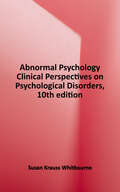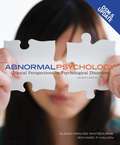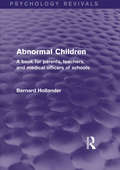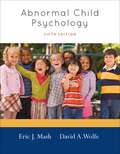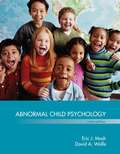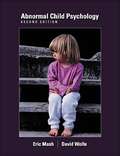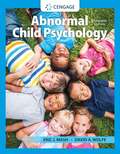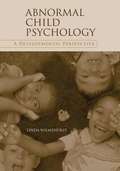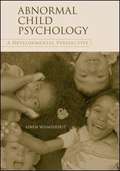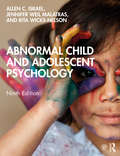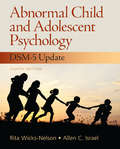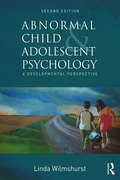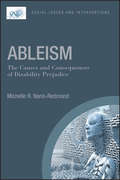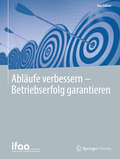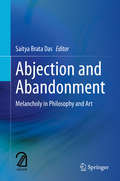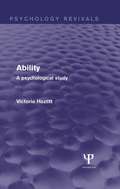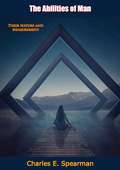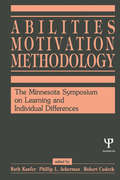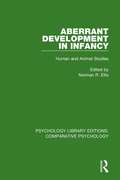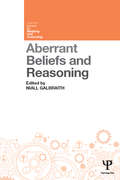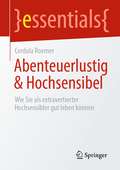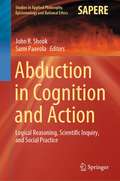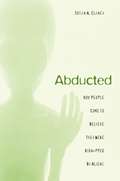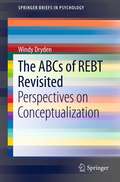- Table View
- List View
Abnormal Psychology: Clinical Perspectives on Psychological Disorders
by Susan Krauss WhitbournePresenting the human side of Psychological Disorders. Susan Krauss Whitbourne's Abnormal Psychology: Clinical Perspectives on Psychological Disorders, shows students real-life portrayals of psychological disorders through an extensive use of clinical and online case studies, biographies, and first-person quotations.
Abnormal Psychology: Clinical Perspectives on Psychological Disorders with DSM-5 Update
by Susan Krauss Whitbourne Richard HalginIn Susan Krauss Whitbourne and Richard Halgin's "Abnormal Psychology: Clinical Perspectives on Psychological Disorders," students are shown the human side of Abnormal Psychology. Through the widespread use of current and relevant clinical case studies, and the biographies and first-person quotations in the Real Stories feature, students are presented with real-life portrayals of the disorders featured in the text. The text maintains the integrative approach to treatment using the biopsychosocial model, and acknowledges the evolution of psychological disorders over the lifespan.
Abnormal Children: A Book for Parents, Teachers, and Medical Officers of Schools (Psychology Revivals)
by Bernard HollanderBorn in Vienna in 1864, Bernard Hollander was a London-based psychiatrist. He is best known for being one of the main proponents of phrenology. This title, originally published in 1916, deals with "the nervous defects of children, and the various forms and degrees of mental and moral deficiency that may occur from infancy up to the age of twenty-one." Very much of its time, it looks at both what it calls the "subnormal" and the "supernormal" child, the causes of abnormality, and suggests ways of educating children in order to minimise their defects and maximise their abilities. This is an opportunity to enjoy a historical look at child psychology from the early twentieth century.
Abnormal Child Psychology (Fifth Edition)
by Eric J. Mash David A. WolfeThis book's thoughtful and accurate balance of developmental, clinical-diagnostic, and experimental approaches to child and adolescent psychopathology is accessible to a broad range of readers. Up-to-date and forward-looking, the book continues to provide the most authoritative, scholarly, and comprehensive coverage of these subjects, tracing the developmental course of each disorder and showing how biological, psychological, and sociocultural factors interact with a child's environment. Coverage includes the DSM-IV-TR and dimensional approaches to classification as well as evidence-based assessment and treatment, contemporary research, and the latest theories related to the predominantly inattentive ADHD subtype, early-onset and the developmental propensity model of conduct disorder, the triple vulnerability model of anxiety, the tripartite model in children, depression, and autism.
Abnormal Child Psychology
by Eric J. Mash David A. WolfeThis edition has been organized and updated to reflect DSM-5 categories, as well as dimensional approaches to classification and evidence-based assessment and treatment. Accessible to a broad range of readers, the book traces the developmental course of each disorder. It also shows how child psychopathology involves biological, psychological, and sociocultural factors interacting with a child's environment. Case histories, case examples, and first-person accounts are at the heart of the book, illustrating the categorical and dimensional approaches used to describe disorders and bringing life to the theories discussed. The authors also consistently illustrate how troubled children behave in their natural settings: homes, schools, and communities.
Abnormal Child Psychology
by Eric Mash David WolfeThe past decade has produced extraordinary advances in understanding the special issues pertaining to abnormal child psychology.
Abnormal Child Psychology (Mindtap Course List)
by Eric Mash David WolfeABNORMAL CHILD PSYCHOLOGY, 7th Edition introduces you to childhood and adolescent disorders, treatment, and prevention using an approach that recognizes the interconnectedness of biological, psychological, social, and emotional influences. You'll view each disorder from the perspective of the whole child, with diagnostic criteria as well as emphasis on the strengths of the individual, environmental circumstances, issues pertaining to younger and older age groups, and the risk and protective factors affecting developmental pathways. Case histories, examples, and first-person accounts are at the heart of the text, bringing to life theories, disorders, and the real people who are affected by them.
Abnormal Child Psychology: A Developmental Perspective
by Linda WilmshurstAbnormal Child Psychology: A Developmental Perspective is intended for undergraduate and Masters-level students enrolled in courses in Abnormal Child and Adolescent Psychology. Written from a developmental perspective, the book is organized around five prominent and recurring themes: the course of normal development proceeds in an orderly and predictable direction; maladaptive behaviors represent deviations from the normal path; maladaptive behavior is represented by a continuum of severity (symptoms, syndromes, disorders) based on the degree to which behaviors deviate from the norm; individual, interpersonal, contextual and cultural factors interact in a reciprocal way to influence normal development and abnormal deviations; theoretical input from diverse perspectives can guide our understanding of underlying processes that precipitate and maintain behaviors and the different developmental pathways that might result. The text provides students with a learning model which incorporates three essential cornerstones, which are pivotal to understanding child and adolescent psychopathology: the K3 paradigm that consists of knowledge of developmental expectations, knowledge of the sources of influence, and knowledge of the theoretical models. Each chapter opens with a case illustration to highlight the themes of the material that follows. The chapters conclude with a Summary Review, Glossary of New Terms and a Set of Review Questions.
Abnormal Child Psychology: A Developmental Perspective
by Linda WilmshurstAbnormal Child Psychology: A Developmental Perspectiveis intended for undergraduate and Masters-level students enrolled in courses in Abnormal Child and Adolescent Psychology. Written from a developmental perspective, the book is organized around five prominent and recurring themes: the course of normal development proceeds in an orderly and predictable direction; maladaptive behaviors represent deviations from the normal path; maladaptive behavior is represented by a continuum of severity (symptoms, syndromes, disorders) based on the degree to which behaviors deviate from the norm; individual, interpersonal, contextual and cultural factors interact in a reciprocal way to influence normal development and abnormal deviations; theoretical input from diverse perspectives can guide our understanding of underlying processes that precipitate and maintain behaviors and the different developmental pathways that might result. The text provides students with a learning model which incorporates three essential cornerstones, which are pivotal to understanding child and adolescent psychopathology: the K3 paradigm that consists of knowledge of developmental expectations, knowledge of the sources of influence, and knowledge of the theoretical models. Each chapter opens with a case illustration to highlight the themes of the material that follows. The chapters conclude with a Summary Review, Glossary of New Terms and a Set of Review Questions.
Abnormal Child and Adolescent Psychology: International Edition (Mysearchlab Series 15% Off Ser.)
by Allen C. Israel Jennifer Weil Malatras Rita Wicks-NelsonAbnormal Child and Adolescent Psychology is a comprehensive introduction to the field. It covers theoretical and methodological foundations and examines the characteristics, epidemiology, etiology, developmental course, assessment, and treatment of disorders of childhood and adolescence. At the heart of the text is the partnership of the developmental psychopathology perspective, which analyzes problems of youth within a developmental context, and a traditional clinical/disorder approach, which underscores the symptoms, causes, and treatments of disorders. Woven throughout the text is the view that behavior stems from the continuous interaction of multiple influences, that the problems of the young are intricately tied to their social and cultural contexts, and that empirical approaches and the scientific method provide the best avenue for understanding the complexity of human behavior. This edition explores the latest areas of research and tackles important contemporary topics, including: how to best classify and diagnose problems the Research Domain Criteria (RDoC) framework the roles of genetics and early brain development and their interaction with the environment the complex roles of family and peers; sex/gender; and culture, ethnicity, and race in psychopathology progress in early intervention and prevention improvements in accessibility and dissemination of evidence-based treatments social issues such as poverty, child maltreatment, substance use, bullying/victimization, and terrorism and war This edition also features a new full-color design and over 150 color figures, tables, and photos. The text is written in a clear and engaging style and is approachable for students with varying academic backgrounds and experiences. It is rich in case descriptions that allow students to examine problems through the lens of youth and their families. The "Accent" boxes foster discussion of current interest topics such as infant mental health, scientific evidence regarding vaccines and autism, suicidality in sexual minority youth, and the impact of stigmatization. The "Looking Forward" sections focus students’ attention on the central concepts to be addressed, while the "Looking Back" sections provide students with a synopsis of the chapter an overview of the concepts for further study and reflection. The text is also supplemented with online resources for students and instructors.
Abnormal Child and Adolescent Psychology: Pearson New International Edition CourseSmart eTextbook
by Rita Wicks-NelsonAbnormal Child and Adolescent Psychology with DSM-5 Updates, 8/e presents students with a comprehensive, research-based introduction to understanding child and adolescent psychopathology. The authors provide a logically formatted and easy to understand text that covers the central issues and theoretical and methodological foundations of childhood behavior disorders. Rich with illustrations and examples, this text highlights the newest areas of research and clinical work, stressing supported treatments and the prevention of behavior problems of youth.
Abnormal Child and Adolescent Psychology: A Developmental Perspective, Second Edition
by Linda WilmshurstWritten from a developmental perspective, Abnormal Child and Adolescent Psychology is organized around five prominent and recurring themes: the course of normal development proceeds in an orderly and predictable direction; maladaptive behaviors represent deviations from the normal path; maladaptive behavior is represented by a continuum of severity (symptoms, syndromes, disorders) based on the degree to which behaviors deviate from the norm; individual, interpersonal, contextual and cultural factors interact in a reciprocal way to influence normal development and abnormal deviations; theoretical input from diverse perspectives can guide our understanding of underlying processes that precipitate and maintain behaviors and the different developmental pathways that might result. The revision will be divided into 5 sections, all integrating the DSM-5, and will include a new chapter on child maltreatment and self injurious behavior.
Ableism: The Causes and Consequences of Disability Prejudice (Contemporary Social Issues)
by Michelle R. Nario-RedmondThe first comprehensive volume to integrate social-scientific literature on the origins and manifestations of prejudice against disabled people Ableism, prejudice against disabled people stereotyped as incompetent and dependent, can elicit a range of reactions that include fear, contempt, pity, and inspiration. Current literature—often narrowly focused on a specific aspect of the subject or limited in scope to psychoanalytic tradition—fails to examine the many origins and manifestations of ableism. Filling a significant gap in the field, Ableism: The Causes and Consequences of Disability Prejudice is the first work to synthesize classic and contemporary studies on the evolutionary, ideological, and cognitive-emotional sources of ableism. This comprehensive volume examines new manifestations of ableism, summarizes the state of research on disability prejudice, and explores real-world personal accounts and interventions to illustrate the various forms and impacts of ableism. This important contribution to the field combines evidence from multiple theoretical perspectives, including published and unpublished work from both disabled and nondisabled constituents, on the causes, consequences, and elimination of disability prejudice. Each chapter places findings in the context of contemporary theories—identifying methodological limits and suggesting alternative interpretations. Topics include the evolutionary and existential origins of disability prejudice, cultural and impairment-specific stereotypes, interventions to reduce prejudice, and how to effect social change through collective action and advocacy. Adopting a holistic approach to the study of disability prejudice, this accessibly-written volume: Provides an inclusive, up-to-date exploration of the origins and expressions of ableism Addresses how to resist ableist practices, prioritize accessible policies, and create more equitable social relations with pages earmarked for activists and allies Focuses on interpersonal and intergroup analysis from a social-psychological perspective Integrates research from multiple disciplines to illustrate critical cognitive, affective and behavioral mechanisms and manifestations of ableism Suggests future research directions based on topics covered in each chapter Ableism: The Causes and Consequences of Disability Prejudice is an important resource for social, community and rehabilitation psychologists, scholars and researchers of disability studies, and students, activists, and academics across political, sociological, and humanistic disciplines.
Abläufe verbessern - Betriebserfolg garantieren (ifaa-Edition)
by Institut für angewandte ArbeitswissenschDer Leitfaden »Abläufe verbessern – Betriebserfolg garantieren« unterstützt Führungskräfte und Mitarbeiter, Verbesserungen betrieblicher Abläufe im Alltag erfolgreich voranzutreiben und nachhaltig zu sichern. Ziele sind, den Wertschöpfungsanteil betrieblicher Abläufe stetig zu erhöhen und Verschwendung in den Produktions- und Arbeitssystemen des gesamten Unternehmens zu erkennen und zu vermeiden. Die Grundlagen hierfür sind eine klar strukturierte Vorgehensweise und die konsequente Nutzung von Zahlen, Daten und Fakten. Die Vorgehensweise berücksichtigt erfolgsrelevante Elemente bewährter Verbesserungsmethoden – wie Six Sigma, PDCA-Zyklus, 8-D Report, REFA-Planungssystematik u. a. – in pragmatischer Form. Zu den einzelnen Arbeitsschritten sind bewährte Werkzeuge in direkt anwendbarer Form verfügbar. Anschauliche Beispiele aus der Praxis ergänzen das Angebot. Seit der ersten Auflage dieses Leitfadens im Jahre 2008 haben zahlreiche Unternehmen die im Leitfaden beschriebene Vorgehensweise erfolgreich umgesetzt. Die Anwender bestätigten den Mehrwert des Leitfadens sowie ihre positiven Erfahrungen und Ergebnisse in einer begleitenden Befragung.
Abjection and Abandonment: Melancholy in Philosophy and Art
by Saitya Brata DasThis book provides a thorough and insightful examination of melancholy in philosophy and art. Since the advent of “philosophy,” the question of melancholy has been intimately connected with creativity. In addition, melancholy has taken on a new importance in contemporary discourses. Accordingly, this book revisits the fascinating question of how melancholy and creativity are linked in light of contemporary thought, and gathers studies from diverse disciplines, such as aesthetic theories, psychoanalysis, cultural theory, medical studies and sociological studies. All the contributions are trans-disciplinary in nature and will broaden readers’ understanding of various issues stemming from the question of melancholy. This book will be an indispensable read for scholars, researchers and practitioners in psychology, psychoanalysis, philosophy and related fields.
Abject Relations: Everyday Worlds of Anorexia
by Megan WarinAbject Relations presents an alternative approach to anorexia, long considered the epitome of a Western obsession with individualism, beauty, self-control, and autonomy. Through detailed ethnographic investigations, Megan Warin looks at the heart of what it means to live with anorexia on a daily basis. Participants describe difficulties with social relatedness, not being at home in their body, and feeling disgusting and worthless. For them, anorexia becomes a seductive and empowering practice that cleanses bodies of shame and guilt, becomes a friend and support, and allows them to forge new social relations. Unraveling anorexia's complex relationships and contradictions, Warin provides a new theoretical perspective rooted in a socio-cultural context of bodies and gender. Abject Relations departs from conventional psychotherapy approaches and offers a different "logic," one that involves the shifting forces of power, disgust, and desire and provides new ways of thinking that may have implications for future treatment regimes.
Ability: A Psychological Study (Psychology Revivals)
by Victoria HazlittOriginally published in 1926, the first part of this book attempted to formulate a theory of ability in the light of recent experimental results of the time. It discusses the nature of intelligence and the problem of special abilities, and includes a study of some typical forms of genius. The second part gives an account of a three years’ experimental study of special abilities in arts and science respectively, carried out upon university students. Samples of the tests employed are included. The results are presented in non-technical form. Victoria Hazlitt was a pioneer of experimental psychology, which was particularly significant as a woman in the early twentieth century. In many cases her work anticipated later developments in psychology by many years. Today it can be enjoyed in its historical context.
The Abilities of Man: Their Nature and Measurement
by Charles E. SpearmanDR. T. PERCY NUNN IN THE BRITISH JOURNAL OF PSYCHOLOGY.—“In the book before us, Prof. Spearman claims nothing less than to have supplied psychology with a body of principles comparable with the first principles of physics. It is a large claim, even though confined to the psychology of cognition, and if substantiated will secure for its author an enviable place in the history of science....A work which, whatever place it may ultimately assume, is unquestionably one of signal importance....A very remarkable and perhaps epoch-making book.”THE HON. BERTRAND RUSSELL IN THE NATION AND THE ATHENAEUM.—“A sober and learned, but thoroughly readable discussion....The book is valuable for its wide knowledge, its lucid discussions, and its thoroughly scientific spirit.”THE TIMES LITERARY SUPPLEMENT.—“The whole work is excellent, a model of lucid exposition.”PROF. C. W. VALENTINE IN MIND.—“This volume gives us in convenient compass not only the essential conclusions of some of Prof. Spearman’s valuable researches but a very remarkable additional contribution to the psychology of cognition.”THE DAILY NEWS.—“One of the most important works on psychology we have had for some time....A sound and brilliant piece of exposition.”THE SUNDAY TIMES.—“A book of the highest value.”
Abilities, Motivation and Methodology: The Minnesota Symposium on Learning and Individual Differences
by Ruth Kanfer Phillip L. Ackerman Robert CudeckDiverse developments in ability and motivation research, and in the derivations of new methodological techniques have often run on parallel courses. The editors of this volume felt that communication across domains could be vastly improved through intensive interaction between researchers. This interaction was realized in The Minnesota Symposium on Learning and Individual Differences, which directly addressed ability, motivation and methodology concerns. This book, compiled as a result of the Symposium, unites theoretical and empirical advances in learning and individual differences. The resulting volume, divided in five parts, encompasses not only prepared papers that were presented at the symposium, but compiled and edited transcriptions of the spontaneous discussions that took place at the symposium. Part I provides an orientation to the treatment of learning and individual differences from three major perspectives: experimental psychology, motivational psychology, and differential/ methodological psychology. Part II continues and expands the discussion of quantitative methodology and applications to learning and individual differences. Part III is devoted primarily to developments in the cognitive ability domain, while Part IV addresses the impact of non-cognitive, personal constructs on learning and performance. The volume concludes with Part V which contains chapters from the closing session of the conference.
Aberrant Development in Infancy: Human and Animal Studies (Psychology Library Editions: Comparative Psychology)
by Norman R. EllisOriginally published in 1975, this volume deals with animals and human infants. The chapters reflect a mixture of issues and problems ranging from the significance of sucking responses in the newborn, the development of memory, effects of rearing conditions in monkeys, and brain damage in animals, to processes underlying abnormal development of language. While it appears the issues are diverse, there is actually a common theme. One question is posed: How and why does normal development fail to occur in some human infants? The chapters show that there are many causes of aberrations: physical or psychological trauma, disease, inheritance, and drugs. Although one may be primary, "multiple causation" would still appear to be a sound principle in developmental pathology.
Aberrant Beliefs and Reasoning (Current Issues in Thinking and Reasoning)
by Niall GalbraithAn aberrant belief is extreme or unusual in nature. In the most serious cases these beliefs cause emotional distress in those who hold them, and typify the core symptoms of psychological disorders. Each of the chapters in this volume seeks to examine the role that biases in reasoning can play in the formation of aberrant beliefs. The chapters consider several conjectures about the role of reasoning in aberrant belief, including the role of the jumping to conclusion bias in delusional beliefs, the probabilistic bias in paranormal beliefs, the role of danger confirming reasoning in phobias, and the controversial notion that people with schizophrenia do not succumb to specific forms of reasoning bias. There are also chapters evaluating different theoretical perspectives, and suggestions for future research. Aberrant Beliefs and Reasoning is the first volume presenting an overview of contemporary research in this growing subject area. It will be essential reading for academics and students in the fields of human reasoning, cognitive psychology and philosophy, and will also be of great interest to clinicians and psychiatrists.
Abenteuerlustig & Hochsensibel: Wie Sie als extravertierter Hochsensibler gut leben können (essentials)
by Cordula RoemerAgil, gesellig und empfindsam? Hochsensibilität gilt allgemein als eine eher introvertierte Veranlagung. Dennoch gibt es feinfühlige Menschen, die sowohl empfindsam sind und sich zugleich extravertiert durch das Leben bewegen. Wie aber passt dies beides zusammen? Schließen sich die beiden Wesenszüge nicht einander aus? Diesen und weiteren Fragen folgt die Autorin in einem kritischen Diskurs, um mehr Klarheit in den Dschungel unterschiedlicher Zuschreibungen und Erklärungen zu bringen. Dieser Diskurs möchte dazu beitragen, die Gefahr einer möglichen Fehlinterpretation im Rahmen einer fachspezifischen Begleitung in Beratung, Coaching und Therapie bei hochsensiblen Menschen zu verringern. Der zweite Teil des Buches gibt Ihnen umfangreiche und vielfältige Tipps und Methoden zum Umgang mit einer extravertierten Hochsensibilität an die Hand.
Abduction in Cognition and Action: Logical Reasoning, Scientific Inquiry, and Social Practice (Studies in Applied Philosophy, Epistemology and Rational Ethics #59)
by John R. Shook Sami PaavolaThis book gathers together novel essays on the state-of-the-art research into the logic and practice of abduction. In many ways, abduction has become established and essential to several fields, such as logic, cognitive science, artificial intelligence, philosophy of science, and methodology. In recent years this interest in abduction’s many aspects and functions has accelerated. There are evidently several different interpretations and uses for abduction. Many fundamental questions on abduction remain open. How is abduction manifested in human cognition and intelligence? What kinds or types of abduction can be discerned? What is the role for abduction in inquiry and mathematical discovery? The chapters aim at providing answer to these and other current questions. Their contributors have been at the forefront of discussions on abduction, and offer here their updated approaches to the issues that they consider central to abduction’s contemporary relevance. The book is an essential reading for any scholar or professional keeping up with disciplines impacted by the study of abductive reasoning, and its novel development and applications in various fields.
Abducted: How People Come to Believe They Were Kidnapped by Aliens
by Susan A. ClancyThey are tiny. They are tall. They are gray. They are green. They survey our world with enormous glowing eyes. To conduct their shocking experiments, they creep in at night to carry humans off to their spaceships. Yet there is no evidence that they exist at all. So how could anyone believe he or she was abducted by aliens? Or want to believe it? To answer these questions, psychologist Susan Clancy interviewed and evaluated "abductees"--old and young, male and female, religious and agnostic. She listened closely to their stories--how they struggled to explain something strange in their remembered experience, how abduction seemed plausible, and how, having suspected abduction, they began to recollect it, aided by suggestion and hypnosis. Clancy argues that abductees are sane and intelligent people who have unwittingly created vivid false memories from a toxic mix of nightmares, culturally available texts (abduction reports began only after stories of extraterrestrials appeared in films and on TV), and a powerful drive for meaning that science is unable to satisfy. For them, otherworldly terror can become a transforming, even inspiring experience. "Being abducted," writes Clancy, "may be a baptism in the new religion of this millennium." This book is not only a subtle exploration of the workings of memory, but a sensitive inquiry into the nature of belief.
The ABCs of REBT Revisited
by Windy DrydenThe cornerstone of Rational Emotive Behavior Therapy is its ABC framework which helps therapists make sense of clients' problems. As it turns out, however, this model is often misunderstood by both clients and professionals. Research investigation on this misunderstanding forms the basis of this book. It addresses the doubts, reservations and objections clients had to the ABC framework in a research study of an REBT-based program in a psychiatric hospital. Additionally, errors and confusions on the part of those writing about the therapy is reviewed. Further, study was made on the accuracy of REBT therapists, themselves, in teaching this therapy to students. Also included is an analysis of how Albert Ellis, himself, has explicated the ABC's. This book is the first to systematically study how different groups conceptualise the ABCs of REBT and the errors that are commonly made in interpreting and putting them into practice. It will be of value to students and practitioners of REBT, and those teaching REBT in academic settings.
